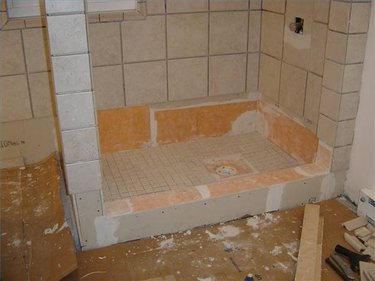Things You'll Need
Polyethylene or roofing felt
Wire mesh
Nails or staples
Staple gun or hammer
Backerboard
Screws
Power drill with screw bits
Tape measure
Pencil
Mortar pan
Portland cement
Trowel
Sand
Water
Thinset
Fabric liner material
Sheet of cardboard
Corner movement profiles

A shower is a traditional addition to most home remodeling plans. The hardest part of installing a shower is creating the waterproof shower pan. If you have a wooden floor, you have to be especially careful since any leakage will cause wood rot and fungus growth, which will eventually have to be removed and the entire process started again. There are newer materials that cost a little more but save a lot of time when installing the shower pan. The fabric system is the easiest method for a novice and it also saves time and energy.
Step 1
Purchase 4mL polyethylene or 15-lb. roofing felt to spread out over the wooden subfloor. When you install a shower pan over a wooden floor, this is not just an added line of defense for the floor, it also prevents the wood from absorbing the concrete's moisture too quickly and allows it to cure properly. Put a layer of galvanized mesh wire on top of the plastic and secure it with nails or staples. If you use 1 1/4-inch galvanized roofing nails, set them at 6-inch intervals. Hang the concrete backerboard walls.
Video of the Day
Step 2
Measure the distance from the wall down to the drain. You need a slope that is 1/4 inch for each foot. This prevents any standing water. Measure up the wall and draw a line all the way around the shower stall. Use a level and straight edge. If you draw a second line about 1/2 inch above it, it acts as a guide in case you cover the first line.
Step 3
Mix up the mortar. The combination that works best is one part Portland cement to three or four parts sand. Add enough water to allow the mixture to form a ball that doesn't break if you drop it. Too little water causes it to crumble. Contractors refer to this as the "bounce test."
Step 4
Lay the mortar from the outside border toward the inside. Start by building a ridge at the height you marked on the frame and gradually slope it toward the drain. Put some mortar around the drain and press it into place. Make sure it's adequately lower than the outside. Use a level to find the pitch. Allow this to dry overnight.
Step 5
Apply a layer of thinset on top of the dried mortar with a V-notched trowel that's 1/4" by 3/16". Place the precut fabric shower pan liner on top of the thinset and smooth into place. The fabric has fleece webbing on both sides and waterproof polyethylene in the center. Work it until you get the matting smooth to the surface and make sure that it bonds everywhere, with no air pockets so that it's watertight.
Step 6
Lay down cardboard to protect the fabric as you do the wall-to-floor connections. Use fabric strips to build the shower pan waterproofing. Put the thinset on the floor and wall, focusing on the inside edge. Press the fabric into place with the trowel on both the pan and the wall. You need to notch the corners for a two-inch overlap. You'll need to apply the thinset then the fabric on the outside and inside corners. Coat with thinset as a seal. Use the thinset as your base and then apply the fabric to the walls, just as you would hang wallpaper. Make sure that every square inch has at least a single layer of fabric and there's overlap at the seams.
Step 7
Add the finishing touches with corner movement profiles. These eliminate the need for a sealant. Put the profiles into place after you apply a coat of thinset at the seams. Seal them with another coat of thinset. Allow this to dry overnight. Test the pan to see if it's waterproof. Plug the drain and fill it with two inches of water. Allow it to set overnight. If the water is still at the same height the next day, your shower pan over the wooden floor is waterproof. It's now ready for finishing touches like ceramic tile.
Video of the Day